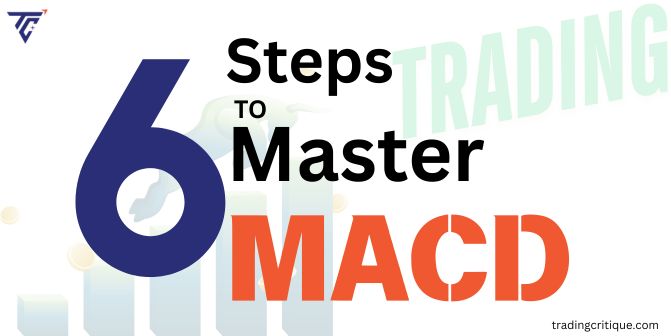Mastering the MACD (Moving Average Convergence Divergence) can significantly improve your trading strategy. In this article, we will discuss the six simple steps to help you master this powerful indicator and how to use MACD indicator successfully by 2025.
Introduction to MACD: Understanding the Basics
The MACD Moving Average Convergence Divergence is a popular technical analysis tool that helps traders identify the strength, momentum, direction, and potential reversal points in the price of a financial asset. Learn more about how to use moving averages in forex trading 2025.
While the Simple Moving Average (SMA) calculates the average price of a security over a period of time, MACD acts as a momentum-based indicator by showing the relationship between two EMAs. MACD is widely used across various markets like stocks, forex, and cryptocurrencies.
What is MACD?
The MACD is typically a trend-following momentum indicator that shows the relationship between two moving averages of an asset’s price. To be specific, it represents the difference between the 12-day Exponential Moving Average (EMA) and the 26-day Exponential Moving Average (EMA).
Components of MACD
No matter which financial market you are trading, the MACD indicator provides the best result. Below are the key components of MACD:
MACD line
The MACD line is the difference between the 12-day and 26-day EMAs and it oscillates above and below the zero line. The movement of this line indicates whether the market is in an uptrend or downtrend.
Signal line
This is a 9-day EMA of the MACD line, acting as a trigger for buy and sell signals. When the MACD line crosses above the signal line, it is generally viewed as a bullish signal. On the contrary, when it crosses below the signal line, it is considered a bearish signal.
Histogram
The histogram represents the difference between the MACD line and the signal line. If the MACD line is above the signal line, the histogram is positive, indicating upward momentum. When the MACD line is below the signal line, the histogram is negative indicating downward momentum.
Working of MACD
MACD is designed to capture momentum and identify potential turning points in the market. It helps traders in the following ways:
Trend strength
As long as the gap between the MACD line and the signal line is wider, the trend is considered stronger.
Trend reversals
Crossovers between the MACD line and the signal line indicate potential buy or sell opportunities.
Divergence
MACD divergence occurs when the MACD moves in the opposite direction to the price movement of an asset. This could signal a potential reversal of the trend.
6 MACD trading strategies 2025
Let us see the 6 simple key strategies that help you to master MACD and use it successfully in 2025:
1. Understand the basics
It is essential to understand the basics of MACD as it provides clear, actionable insights into market trends, momentum, and potential reversals. It also helps you to make objective trading decisions, reduce emotional trading, and enhance the effectiveness of your trading strategy. Below are the key reasons to understand the basics of this widely used MACD indicator:
- Helps in trend identification
- Provides clear sell and buy signals
- Helps spot divergences
- Acts as supporting indicator with other technical indicators
- Adjustable to various time frames
- Helps identifying market sentiment
2. Learn the key signals
The MACD indicator generates several important signals that help traders identify buy and sell opportunities. According to the time frames chosen, traders can enter into short term or long-term positions. Below are the key signals a trader should look for while using MACD:
MACD crossover
A crossover occurs when the MACD line (difference between the 12-period EMA and the 26-period EMA) crosses above or below the signal line (9-period EMA of the MACD line). A bullish crossover signals a buy and a bearish crossover signals a sell.
Bullish and bearish MACD divergence
A bullish divergence occurs when the price makes lower lows while MACD makes higher lows. A bearish divergence occurs when the price makes higher highs while MACD makes lower highs. Traders often look to sell or short when they spot a bearish divergence and vice versa.
Zero line crossovers
A bullish zero line crossover occurs when the MACD line crosses above the horizontal line and a bearish zero line crossover occurs when the MACD line crosses below the zero line. Traders can make sell or buy decisions accordingly based on the crossover.
3. Combine with other indicators
Expert traders generally use MACE in conjunction with other trading indicators such as the Relative Strength Index (RSI), support and resistance levels, or candlestick patterns to confirm trade signals. For example, if you see a bearish MACD crossover at a resistance level, combined with a bearish engulfing candlestick pattern, it clearly suggests a fall in price.
Rather than depending on a single indicator, it is necessary to confirm with other supporting indicators too before taking a bullish or bearish stance.
4. Adjust different time frames
It is obvious that you will get more comprehensive view of the market by combining signals from multiple time frames. Using the MACD indicator across different time frames provides deeper insights into market trends and helps you refine your trading strategy from time to time.
It is important to understand the difference between the time frames before taking a call. For example, if the daily MACD indicates a bullish trend, you might consider looking for buying opportunities on the 4-hour or 1-hour charts. Choosing the right time frame plays an important role in your trading decisions as a wrong call may lead to potential loss.
5. Backtest strategies
Backtesting in MACD is an essential step in evaluating the effectiveness of your trading strategy. You need to backtest your strategy to see how it performs over time as this will help you to refine your approach and avoid unnecessary risks.
In order to save time, traders prefer to use backtesting software or tools that automatically execute your strategy based on historical data. This helps you to focus on the analysis part. The key considerations during backtesting are:
- Ensure your historical data quality and accuracy is good.
- Be careful of overfitting your strategy to the historical data.
- Do backtest across different market conditions to ensure the robustness of your strategy.
6. Manage risk effectively
No matter what asset you are trading, managing risk with the MACD indicator is crucial to ensure you are protecting your capital. Though MACD can provide valuable signals for enter and exit trades, it is the trader’s discretion to combine it with proper risk management techniques. There are several risk management strategies when trading with MACD indicator:
- Using stop-loss orders
- Confirming with supporting indicators
- Using risk-reward ratio
- Avoiding overtrading with MACD
- Monitoring divergence and convergence
- Avoiding consolidation trading
Our 9 tips to set a stop loss and take profits in forex trading helps you effectively manage risk and minimize losses.
Setting Up the MACD Indicator on Your Trading Platform
Setting up the MACD indicator on your trading platform is a simple and straightforward process that can significantly improve your market analysis. In order to enhance your ability to spot trends, momentum shifts, and potential entry/exit points, you should first understand how to customize and interpret the MACD.
It is also very important to combine MACD with other technical indicators and employ a proper risk management strategy for optimal results. Below is a general guide to setting up MACD on trading platforms:
Choose your trading platform
First of all, make sure you have access to a trading platform that supports technical indicators. There are popular platforms that offer MACD such as:
- MetaTrader 4 (MT4) and MetaTrader 5 (MT5)
- TradingView
- eToro
- NinjaTrader etc.
Open a chart
Once you log into your trading platform, select the instrument (stock, forex, crypto, etc.) you wish to analyze. Open a chart for the selected asset and choose the type of chart such as candlestick or bar. Then choose a time period for the asset’s price such as 1 minute, 1 hour, daily, etc.
Locate the indicator section
- Generally, in most platforms, there will be a menu or toolbar in the top menu of the platform, that lists all technical indicators.
- In MetaTrader 4/5, go to Insert à Indicators à Oscillators à MACD.
Apply the MACD indicator
After selecting MACD indicator from the toolbar, you will need to adjust the parameters, where typically the default settings are 12, 26, and 9. The fast EMA is generally set to 12, the slow EMA to 26, and the signal line to 9. You will need to adjust the settings according to your trading preferences and click ok. You can see the MACD will appear at the bottom of the chart.
Customize MACD settings
It is very easy and simple to modify MACD to suit your trading style. You can also change the colors of the lines and histogram to make it better visible according to your personal preferences. You can also switch between time frames such as 1-minute, daily, or weekly, to suit your trading preferences.
Identifying Trend Strength and Direction with MACD
The primary purpose of MACD is to identify the strength and direction of a trend. If the MACD line is above the signal line and moves upward, it indicates a bullish trend with increasing momentum. On the contrary, if the MACD line is below the signal and moves downwards, it signals a bearish trend with decreasing momentum.
MACD also provides information on the duration of a trend by observing the distance between the MACD and signal lines. Widening gaps between the lines imply a prolonged and strong trend.
Utilizing MACD Signal-Line Crossovers for Entry and Exit Points
Generally, a crossover occurs when the MACD line crosses above or below the signal line. Since a crossover signals a potential direction change of a price trend, it is viewed as an important sign. There are two types of MACD crossovers:
- Bullish crossover – occurs when MACD line moves above the signal line.
- Bearish crossover – occurs when MACD line moves below the signal line.
Traders however should look for other indicators such as increased volume, supporting signals, etc before confirming a trend reversal. We do not typically recommend completely relying on MACD to confirm a bullish or bearish outlook.
Conclusion
If you want to understand the market momentum and identify potential trend reversals, MACD is the best indicator we would recommend. We, however, would like to reiterate that no indicator is foolproof and combining MACD with other technical tools often gives reliable results. Also one should be aware of false signals and this comes only through practice.
With continued practice combined with proper risk management, mastering MACD could make you a more effective and informed trader.
Pro Tip
The MACD trading combined with proper risk management strategies helps you improve success probability. Explore our trusted forex brokers using our broker finder tool to get a suitable broker service in line with your trading expectations. Discover our investment options like crypto, banking, finance, and trading.









